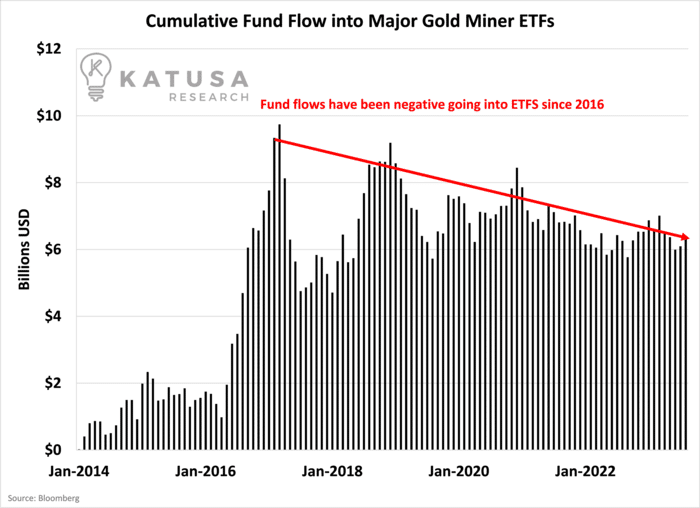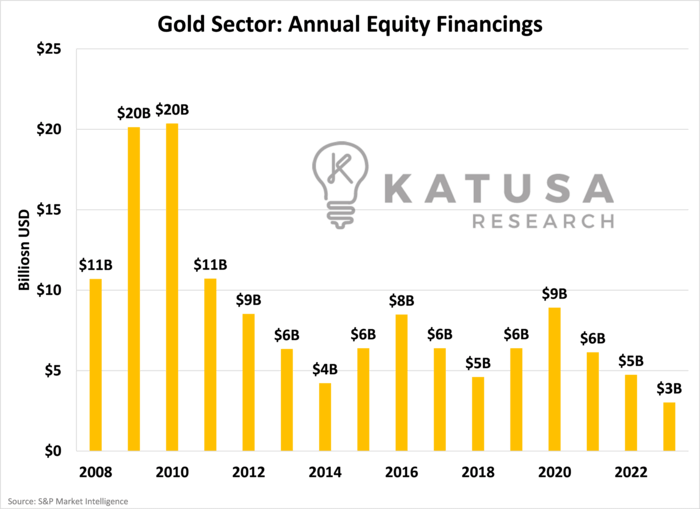
“You can check-out any time you likeBut you can never leave”.
When Don Henley and Glenn Frey wrote those famous lyrics, little did gold investors think it would be their problem.Like a guest at the infamous Hotel California, gold investors find themselves trapped between a rock (paper) and a hard place (liquidity).Despite being able to “check-in” with ease, escaping this hotel might be trickier than most investors anticipate.
- In this volatile landscape, gold funds wane and lawyers prioritize protection over profitability.
- Investors, once optimistic, now exhibit caution and are often “frozen”. And the flow of funds seems more ebb than flood.
But what lies beneath this shift?
The Liquidity and Volume Problem
In short, gold and nearly the entire resource sector is suffering a problem with liquidity. And more importantly, there are no large new gold funds being created. In fact, the large gold funds are seeing net outflows. This means that the funds are selling to meet redemptions by their unit holders… and any deal the fund wants to buy means they are selling what they already own.Put simply, the generalists are not buying gold stocks. Below is a chart which shows the net creation and redemption of ETF units aka “fund flow” for major gold miner ETFs.

As you can see, fund flow into the sector peaked in mid-2016 and since then, more money has come out of the sector than gone into it.With the lack of fund flow in mind, let’s examine the performance of the mining sector across different segments.
Perhaps the most telling bearish signal is the sheer number of companies that are trading below their 200-day moving average across most industry segments.
Equity Financings: A Lens Into the Appetite for Gold Stocks
One of the best ways to gauge market sentiment and investor optimism is through financing activity.Companies across all sectors are continuously trying to grow, build and acquire new assets and talent.The mining sector is no different, especially when considerable growth comes through mergers rather than internal organic growth from operating sites. This means the companies need to raise cash to trudge on.Below is a chart which shows the total equity financings completed by companies in the gold sector over the years.

Total deals completed this year are roughly half of the previous two years and significantly down since the onset of QE post GFC in 2008.Yet exploration and capex programs have gotten more expensive – as have lawyer and accounting fees.And that means even fewer dollars are going to value creation.
Gold Equities: You Can Check In, But Can You Check Out?
I have written before on the secret killer of the mining sector, which is illiquidity.Misunderstood by most investors, illiquidity can destroy returns.How so? A stock is illiquid when there is minimal trading activity relative to the company’s size and number of free trading shares.
- If a stock is illiquid it makes it difficult to sell shares once purchased, simply because there are few buyers.
- This situation magnifies when there is negative news and all existing shareholders run for the exits and crater the stock.
Next is a chart which shows the dollar volume traded for a group of large gold focused companies, that are listed on major exchanges in Canada and or the USA. Dollar volume is calculated as total number of shares traded multiplied by the average share price of the day.

In recent years you can see it too has been sliding lower, indicating less activity and less investors bringing hard dollars into the sector.The steady decline is noticeable even in these large-cap stocks that generate billions in revenue and have research coverage by many institutions and are held by ETFs.
Before you Invest: Staple This to Your Desk
Our office sees countless resource deals every week from companies looking for financing to companies looking to go public and everything in between.One of the first questions we ask ourselves is “Will this company have a liquid market post-financing?”.You might have excellent project economics… you might have a brilliant and illustrious management team leading…But if you don’t have anyone in the market looking at your stock, do you even exist?As an investor, you must be mindful of shareholder turnover and liquidity in any company you buy.Or else you’ll find yourself in a situation where you can check in any time you like…But can you leave?Regards,Marin Katusa P.S. Every month my team and I publish a detailed look at what I’m investing in and which resource sectors are catching my attention. It’s called Katusa’s Resource Opportunities and you can learn more right here.
Details and Disclosures
Investing can have large potential rewards, but it can also have large potential risks. You must be aware of the risks and be willing to accept them in order to invest in financial instruments, including stocks, options, and futures. Katusa Research makes every best effort in adhering to publishing exemptions and securities laws. By reading this, you agree to all of the following: You understand this to be an expression of opinions and NOT professional advice. You are solely responsible for the use of any content and hold Katusa Research, and all partners, members, and affiliates harmless in any event or claim. If you purchase anything through a link in this email, you should assume that we have an affiliate relationship with the company providing the product or service that you purchase, and that we will be paid in some way. We recommend that you do your own independent research before purchasing anything.







